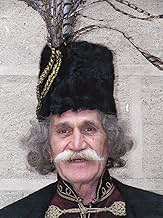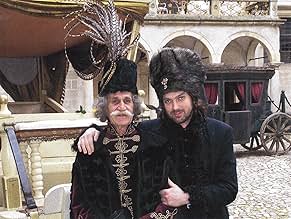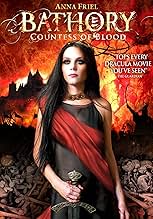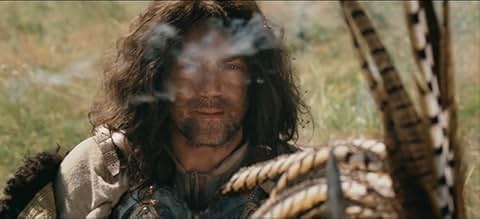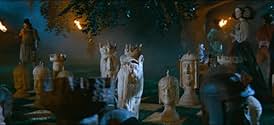NOTE IMDb
5,7/10
4,8 k
MA NOTE
Ajouter une intrigue dans votre langueWith an unquenchable thirst for blood, Countess Elizabeth Bathory was one of the most prolific serial killers in history.With an unquenchable thirst for blood, Countess Elizabeth Bathory was one of the most prolific serial killers in history.With an unquenchable thirst for blood, Countess Elizabeth Bathory was one of the most prolific serial killers in history.
- Réalisation
- Scénario
- Casting principal
- Récompenses
- 5 victoires et 4 nominations au total
Deana Horváthová
- Darvulia
- (as Deana Jakubisková-Horváthová)
Jaromír Nosek
- Miklós Zrínyi
- (as Míra Nosek)
Avis à la une
Lavish, romanticized account of the life and times of 16th century Hungarian countess Erzsébet Bathory, history's most prolific serial killer...
BATHORY, a would-be epic with nice period detail, aspires to myth-buster status by painting the "Bloody Countess of Čachtice" as a victim of political chicanery in a male-dominated society but all it accomplishes is a "legend" of its own by white-washing history, facts be damned. Here, as a wealthy woman who's vast holdings could turn the tide in a power struggle between Catholics and Protestants as they fight off a Muslim invasion, Countess Bathory is more sinned against than sinning and framed for crimes she never committed. Yeah, right. Valentine Penrose & Alexander Trocchi's well-researched "The Bloody Countess: Atrocities Of Erzsébet Bathory", offers a significantly different account based on historical records:
"Descended from one of the most ancient aristocratic families of Europe, Erzsébet Bathory bore the psychotic aberrations of centuries of intermarriage. From adolescence she indulged in sadistic lesbian fantasies where only the spilling of a woman's blood could satisfy her urges. By middle age she had regressed to a mirror-fixated state of pathological necro-sadism involving witchcraft, torture, blood-drinking, cannibalism and, inevitably, wholesale slaughter. These years, at the latter end of the 16th century, witnessed a reign of cruelty unsurpassed in the annals of mass murder with the Countess' depredations on the virgin girls of the Carpathians leading to some 650 deaths. Her many castles were equipped with chambers where she would hideously torture and mutilate her victims, becoming a murder factory where hundreds of girls were killed and processed for the ultimate youth-giving ritual: the bath of blood..."
In Juraj Jakubisko's film, Erzsébet Bathory is depicted as an intelligent woman ahead of her time and a Protestant preyed upon by the Catholic Church as well as her late husband's covetous best friend although she still finds time for a passionate affair with the Italian painter Caravaggio (!) as her subjects try inventing spring-powered roller skates, phonographs, still photography, and primitive airplanes a la Leonardo Da Vinci. The tale, a de-fanged poison valentine to renaissance Hungary, is served up on a grand scale but twists the truth into a monumental mis-carriage of injustice that's recommended to revisionists only. What's next, JEFFREY DAHMER -THE MUSICAL?
BATHORY, a would-be epic with nice period detail, aspires to myth-buster status by painting the "Bloody Countess of Čachtice" as a victim of political chicanery in a male-dominated society but all it accomplishes is a "legend" of its own by white-washing history, facts be damned. Here, as a wealthy woman who's vast holdings could turn the tide in a power struggle between Catholics and Protestants as they fight off a Muslim invasion, Countess Bathory is more sinned against than sinning and framed for crimes she never committed. Yeah, right. Valentine Penrose & Alexander Trocchi's well-researched "The Bloody Countess: Atrocities Of Erzsébet Bathory", offers a significantly different account based on historical records:
"Descended from one of the most ancient aristocratic families of Europe, Erzsébet Bathory bore the psychotic aberrations of centuries of intermarriage. From adolescence she indulged in sadistic lesbian fantasies where only the spilling of a woman's blood could satisfy her urges. By middle age she had regressed to a mirror-fixated state of pathological necro-sadism involving witchcraft, torture, blood-drinking, cannibalism and, inevitably, wholesale slaughter. These years, at the latter end of the 16th century, witnessed a reign of cruelty unsurpassed in the annals of mass murder with the Countess' depredations on the virgin girls of the Carpathians leading to some 650 deaths. Her many castles were equipped with chambers where she would hideously torture and mutilate her victims, becoming a murder factory where hundreds of girls were killed and processed for the ultimate youth-giving ritual: the bath of blood..."
In Juraj Jakubisko's film, Erzsébet Bathory is depicted as an intelligent woman ahead of her time and a Protestant preyed upon by the Catholic Church as well as her late husband's covetous best friend although she still finds time for a passionate affair with the Italian painter Caravaggio (!) as her subjects try inventing spring-powered roller skates, phonographs, still photography, and primitive airplanes a la Leonardo Da Vinci. The tale, a de-fanged poison valentine to renaissance Hungary, is served up on a grand scale but twists the truth into a monumental mis-carriage of injustice that's recommended to revisionists only. What's next, JEFFREY DAHMER -THE MUSICAL?
Fields stained with Turkish blood. Villages and witches burned. High castles and deep catacombs. Bleak life full of vivid imagination. Such is the world Bathory, The Bloody Lady of Cachtice.
Elizabeth Bathory lets you see the film through the eyes of a mother, lover and ruler rather than the legendary serial killer. Throughout the film she strives to protect her children, love and land while ignoring her tainted reputation. The intrigues escalate. Blood is spilled. And a false myth is born.
Although there is a complex epic plot, the film feels more like a series of still pictures. There is a lot of symbolism and the plot slows down so that you can fully enjoy it. Apart from the story, the Bathory also takes some time to explain how myths are created and abused to serve one’s needs. The acting is outstanding but does not stand out as much as the Hungarian costumes that make the film look fresh.
Unfortunately the movie is significantly flawed by repetitive comic relief in which two monks use various inventions to spy on the countess. They seem to have come from another movie and make you question the taste of the writers. Should there be a version without those comedians a 9/10 rating would be appropriate.
Elizabeth Bathory lets you see the film through the eyes of a mother, lover and ruler rather than the legendary serial killer. Throughout the film she strives to protect her children, love and land while ignoring her tainted reputation. The intrigues escalate. Blood is spilled. And a false myth is born.
Although there is a complex epic plot, the film feels more like a series of still pictures. There is a lot of symbolism and the plot slows down so that you can fully enjoy it. Apart from the story, the Bathory also takes some time to explain how myths are created and abused to serve one’s needs. The acting is outstanding but does not stand out as much as the Hungarian costumes that make the film look fresh.
Unfortunately the movie is significantly flawed by repetitive comic relief in which two monks use various inventions to spy on the countess. They seem to have come from another movie and make you question the taste of the writers. Should there be a version without those comedians a 9/10 rating would be appropriate.
1. The dialogue writing and delivery are absolute cringe-worthy the entire duration of the film.
2. The film has a glaring anachronism in every scene.
3. I am not myself obsessed with plot holes, but when there are so many and they are so obvious it makes a viewer certain the writers assume their audience is mentally challenged.
This story follows the rise and fall of one of history's most prolific serial killers, Countess Báthory who supposedly bathed in virgins blood to stay youthful.
This is a comprehensive fictionalised TV version directed and written by Juraj Jakubisko with mixed production values in both tone and atmosphere. The setting is fantastic and breathtaking, however, the exterior scenes lack the Gothic feel that the interiors have.
As a TV film, in several parts, the Monks narration and involvement arguably fits, however, as a film it may have benefited from the omission of the character entirely. You'll also either love or hate the involvement of painter Caravaggio. Historical inaccuracies aside and the unnecessary humour injected usually by the monk, this incarnation of the legend is very interesting and adds food for thought to the tale of Báthory. In addition, it gives an interesting portrayal of politics, religion and royalty of the time.
Anna Friel is fantastic as the miss-judged Erzsébet Báthory and gives a wonderful performance, full of range and emotional depth. It's not all out horror, a possible nod to Ingrid Pitt in Countess Dracula (1970). Co-Star Karel Roden is on top form as Juraj Thurzo and Vincent Regan is notable. The supporting cast do just that. The principle characters have strong motivations for their actions and the morale choices are at times shades of grey.
It's not without its faults but there's a handful of interesting dream and hallucination sequences and enough twists on the tale to keep you watching. This coupled with some fine locations, costumes and performances makes Bathory worth your time.
This is a comprehensive fictionalised TV version directed and written by Juraj Jakubisko with mixed production values in both tone and atmosphere. The setting is fantastic and breathtaking, however, the exterior scenes lack the Gothic feel that the interiors have.
As a TV film, in several parts, the Monks narration and involvement arguably fits, however, as a film it may have benefited from the omission of the character entirely. You'll also either love or hate the involvement of painter Caravaggio. Historical inaccuracies aside and the unnecessary humour injected usually by the monk, this incarnation of the legend is very interesting and adds food for thought to the tale of Báthory. In addition, it gives an interesting portrayal of politics, religion and royalty of the time.
Anna Friel is fantastic as the miss-judged Erzsébet Báthory and gives a wonderful performance, full of range and emotional depth. It's not all out horror, a possible nod to Ingrid Pitt in Countess Dracula (1970). Co-Star Karel Roden is on top form as Juraj Thurzo and Vincent Regan is notable. The supporting cast do just that. The principle characters have strong motivations for their actions and the morale choices are at times shades of grey.
It's not without its faults but there's a handful of interesting dream and hallucination sequences and enough twists on the tale to keep you watching. This coupled with some fine locations, costumes and performances makes Bathory worth your time.
The great thing about this film is it's unique style, which has great flair, very like the best of Ken Russell. It doesn't try to be blandly mainstream, the director is too talented for that, he has too much vision to fit in with the prosaic , boring and anodyne rot usually filling our screens. This film entertains with gusto, flair, beauty and horror. One may quibble with any film and look for faults, but this film is fascinating and compelling, suitable for anyone interested in the drama of the life of Erzsebet Bathory. One soon comes to see through the eyes of the lead characters, their brutal and beautiful world lives and breathes again, shockingly, before our eyes.
Erzsabet's story is told in a such a colourful, dynamic and thoroughly gripping way, that certainly had me looking forward to seeing more, like asking for a second helping of a surprisingly delicious pudding, I relished what I found to be so enjoyable after having heard such bad reviews. Erzsabet's life and times were brutal and this is shown graphically but not too eye wateringly. The performances are highly entertaining and extremely powerful especially the characters of Erzsabet, Caravaggio and Thurzo. Some have quibbled about the English accents of the actors but actually I thought Ezsabet's Hungarian accent rather convincing, the chill of steel to the edge of her voice. It is a very accessible story, so who would be so daft as to require the actors to speak Hungarian and so lose half the audience, who are either too dense or lazy to read subtitles. Frankly a ridiculous quibble, one does not notice anything but how fine the performances truly are.
Visually stunning and beautiful, the script gives us a thumpingly good story and altogether it is a mesmerising piece of cinema. It is so powerful that twenty four hours after watching, it still haunts me and I look forward to seeing more from this director and creative team. I feel I've discovered, at last, a piece of English language cinema that isn't formulaic, that isn't dull and predictable, that isn't the same old same old, that isn't like every other pleasant enough but unimaginative 'product,' here is something unique and artistically brave and exciting.
Altogether I think one would have to be in a very sour and unforgiving mood to find fault. If you want to be entertained and why else watch, everyone should enjoy this unfairly maligned but unusually fascinating film.
Erzsabet's story is told in a such a colourful, dynamic and thoroughly gripping way, that certainly had me looking forward to seeing more, like asking for a second helping of a surprisingly delicious pudding, I relished what I found to be so enjoyable after having heard such bad reviews. Erzsabet's life and times were brutal and this is shown graphically but not too eye wateringly. The performances are highly entertaining and extremely powerful especially the characters of Erzsabet, Caravaggio and Thurzo. Some have quibbled about the English accents of the actors but actually I thought Ezsabet's Hungarian accent rather convincing, the chill of steel to the edge of her voice. It is a very accessible story, so who would be so daft as to require the actors to speak Hungarian and so lose half the audience, who are either too dense or lazy to read subtitles. Frankly a ridiculous quibble, one does not notice anything but how fine the performances truly are.
Visually stunning and beautiful, the script gives us a thumpingly good story and altogether it is a mesmerising piece of cinema. It is so powerful that twenty four hours after watching, it still haunts me and I look forward to seeing more from this director and creative team. I feel I've discovered, at last, a piece of English language cinema that isn't formulaic, that isn't dull and predictable, that isn't the same old same old, that isn't like every other pleasant enough but unimaginative 'product,' here is something unique and artistically brave and exciting.
Altogether I think one would have to be in a very sour and unforgiving mood to find fault. If you want to be entertained and why else watch, everyone should enjoy this unfairly maligned but unusually fascinating film.
Le saviez-vous
- AnecdotesFamke Janssen was originally signed on for the part of Bathory, but for reasons unknown she backed out. Anna Friel read the script and fell in love with it and sent the director a letter convincing him to cast her. It was written in Slovak language, because her babysitter was from Slovakia and helped her writing it.
- ConnexionsReferenced in Vsechnopárty: Épisode datant du 24 juin 2008 (2008)
Meilleurs choix
Connectez-vous pour évaluer et suivre la liste de favoris afin de recevoir des recommandations personnalisées
- How long is Bathory: Countess of Blood?Alimenté par Alexa
Détails
- Date de sortie
- Pays d’origine
- Langue
- Aussi connu sous le nom de
- Chroniques d'Erzebeth
- Lieux de tournage
- Sociétés de production
- Voir plus de crédits d'entreprise sur IMDbPro
Box-office
- Montant brut mondial
- 7 005 528 $US
- Durée2 heures 21 minutes
- Couleur
- Mixage
- Rapport de forme
- 2.35 : 1
Contribuer à cette page
Suggérer une modification ou ajouter du contenu manquant

Lacune principale
By what name was Chroniques d'Erzebeth: Le Royaume Assailli (2008) officially released in India in English?
Répondre


